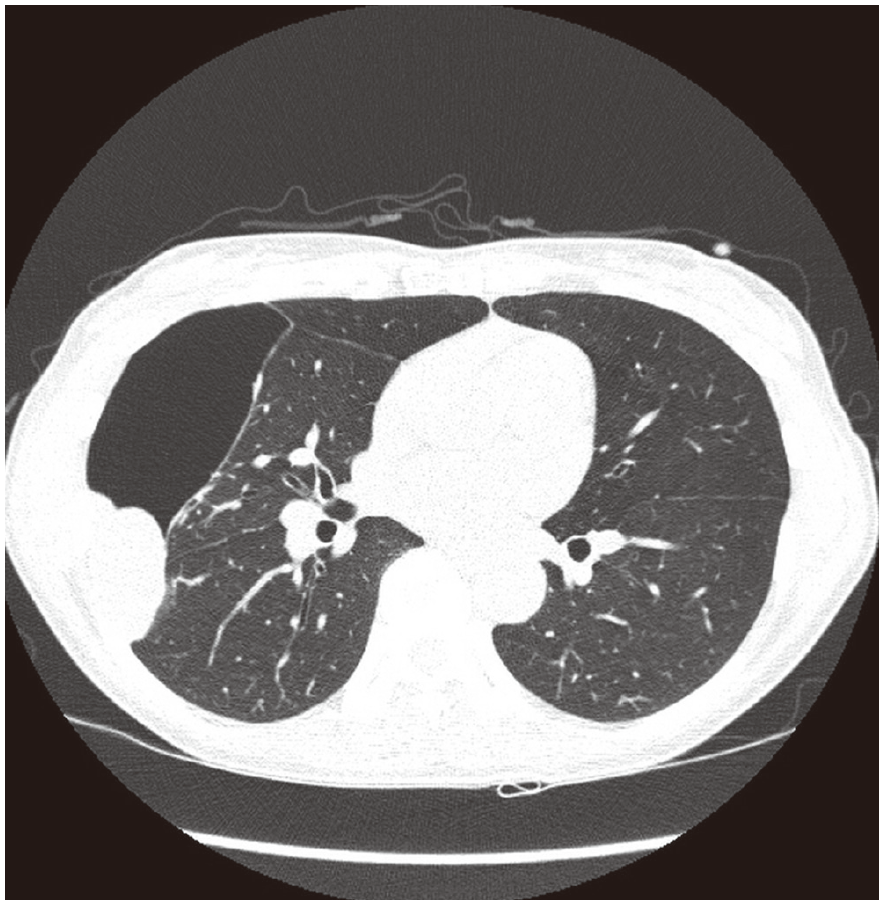INTRODUCTION
Solitary fibrous tumors of the pleura (SFTPs) are rare and SFTPs are different clinical behavior from malignant pleural tumors such as mesothelioma. Most of SFTPs are benign but some tumors grow aggressively. SFTPs grow large but extensive cystic change rarely. Sometimes large cystic SFTPs are misdiagnosed as pneumothorax. We experience a case involving a 52-year-old woman who was misdiagnosed as pneumothorax and underwent video assisted thoracic resection of SFTPs with extensive cyctic change and introduce.
CASE REPORT
A right pleural mass was detected incidentally in a 52-year-old woman during an annual medical checkup. This had not been detected two years earlier. She had no specific symptoms, or medical history. On physical examination, slightly decreased breath sounds were noted in the right lung field. A chest X-ray showed focal opacification in the right lower thorax, suggestive of an extrapleural mass. Contrast-enhanced chest computed tomography (CT) showed a lobulated pleural mass arising from the parietal pleura, with a lobulated elongated contour and mild contrast enhancement, suggesting a localized fibrous tumor of the pleura. A localized pneumothorax was noted (Fig. 1). Other laboratory tests were within the normal range. A CT-guided percutaneous transthoracic needle aspiration biopsy suggested a fibrous tumor of the pleura. The patient underwent thoracoscopic excision of the mass, which originated from the visceral pleura and showed extensive cystic change (Fig. 2). The oval mass measured 8×5×3 cm and was well encapsulated. The pleural surface was ballooned markedly, resulting in bullae formation; the localized ‘pneumothorax’ seen on chest CT was actually a large bulla. The mass was not invasive or aggressive. A frozen biopsy suggested a solitary fibrous tumor. Postoperatively, the patient had no problems and was discharged on postoperative day 5. The histology showed a solitary fibrous tumor with extensive cystic changes.
DISCUSSION
Pleural tumors show various patterns and can be diffuse, e.g., a pleural mesothelioma, or localized, e.g., a fibrous tumor. This rare tumor has been given many names because of its origin and character and was thought to be a benign, localized form of malignant pleural mesothelioma. However, improvements in diagnostic techniques such as immunohistochemical methods and electron microscopy have defined this tumor as SFTPs, revealing its distinct status and histological character from malignant mesothelioma [1].
Solitary fibrous pleural tumors are more common in the fifth and sixth decades of life, but can develop at all ages. There occur equally in males and females. Over 75% of patients with malignant mesotheliomas have respiratory or other symptoms, while only about 50% of SFTP patients have symptoms. Chest pain is the most common symptom and enlarging tumors can compress the bronchus causing atelectasis. Paraneoplastic syndrome can appear if the tumor is large [2]. During a physical examination, if the tumor compresses the bronchus then wheezing, decreased breathing sounds, or dullness are observed. In hypertrophic pulmonary osteoarthropathy patients, clubbing can be present. A simple chest X-ray can roughly describe the tumor size and location, but it is not diagnostic. Chest CT is more accurate and can indicate the tumor size, location, homogenous pattern, and lobulation. Generally this tumor originates from the visceral pleura, but sometimes an SFTP arises from the interlobar or lung parenchyma. They are rarely cystic in nature [3]. Surgical resection is the best treatment option. More than half are pedunculated, and video-assisted thoracic surgery (VATS) is preferred to open surgery [3]. Histologically, SFTPs appear benign, although large tumors can show central necrosis and some atypia [4]. Solitary fibrous tumor is the comprehensive and preferred term for an uncommon, but histologically different spindle cell neoplasm, that was called in the past as fibrous mesothelioma, localized fibrous mesothelioma, localized fibrous tumor, localized mesothelioma, pleural fibroma, solitary fibrous mesothelioma, or submesothelial fibroma. In Korea, there are some reports of SFTPs arising either from mediastinal, diaphragmatic, or parietal pleura, or from within a lung fissure and in various extrapleural locations, such as the retroperitoneum, mediastinum, thyroid gland, nasal cavities, meninges, parietal surfaces of the intra-abdominal viscera, intraparenchymal or endobronchial location. But an SFTP with extensive cystic change is particularly rare and clinically we misidentified this cystic change as a pneumothorax. A pneumothorax is need closed thoracostomy, but this procedure is painful and needs special training. In SFPT patients with pneumothorax, closed thoracostomy is unnecessary procedure, but rather diagnostic VATS is treatment of choice. Therefore, we report the present case.













